A Private Tour today in North Norfolk. The weather was very pleasant – there were some nice sunny spells, before it clouded over a little in the afternoon, with the fresh southerly breeze picking up a bit through the day.
We met in Wells. As we were heading east this morning anyway, we called in at North Point first. There had been a Pacific Golden Plover reported there late yesterday, but there were already messages suggesting there was no sign of it this morning. We were hoping to catch some other migrant waders there instead – August is always a good time to look for migrant waders already on their way south from their arctic breeding grounds.
Scanning from the parking area, we could see lots of Greylag Geese on the pool to the east, loafing around the islands and open water. There seemed to be more waders closer to the track further down, so we set off for a closer look. A young Marsh Harrier drifted over, stirring up some of the birds before circling away over the fields beyond.
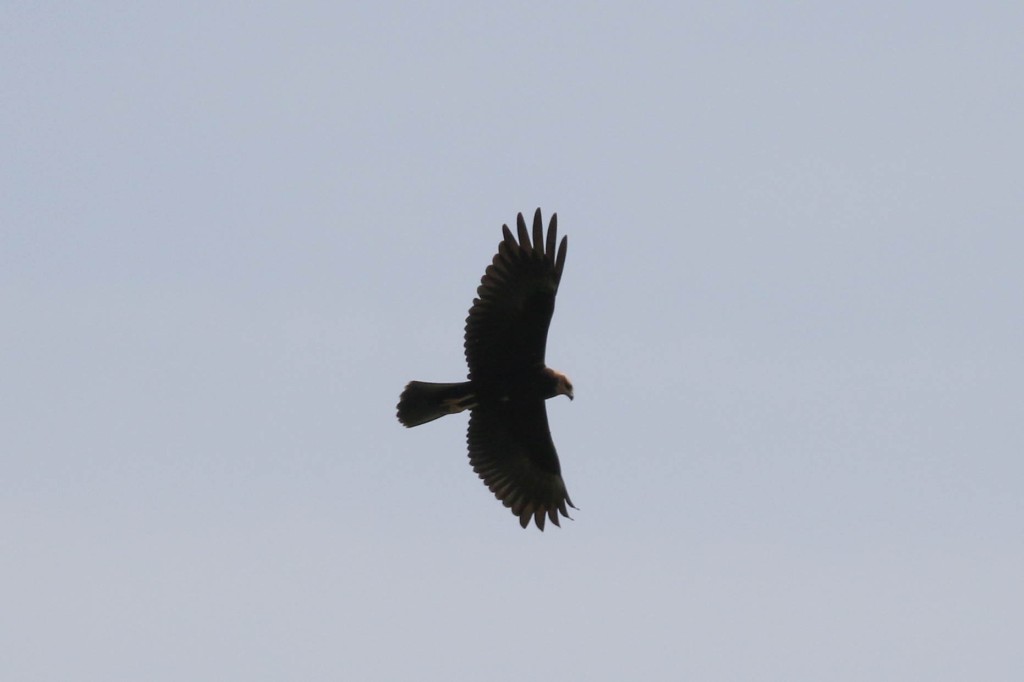
A small group of Black-tailed Godwits was feeding in the water close to the path. On the mud in front of the rushes a little further back, we could see a couple of Ruff, already in their drab non-breeding plumage, and a single Green Sandpiper. We got the scope on them for a closer look. There were one or two Avocets and Lapwings on here too.
Some other birders walking back along the path stopped to tell us that there was a golden plover on the pool the other side. They weren’t sure, but thought it might be the Pacific Golden Plover. From a bit further down the track, we could see the pool over the vegetation, and we could just see the bird in the grass on the edge. It looked promising, but we couldn’t see it clearly from here, so we carried on round to the north side, where we could get a clearer view from the bank.
Sure enough, it was a Pacific Golden Plover, an adult starting to moult out of breeding plumage. Our regular European Golden Plover is very similar in appearance, but we could see the very short primary projection on this bird, together with the remnants of black continuing right down under the tail and the upperparts coarsely patterned with white and pale gold. We had a good look at it through the scope.

Pacific Golden Plover is a rare visitor here, normally breeding in northern Siberia and spending the winter in South Asia and Australasia, with just a handful of records in the UK on average each year. 2021 has been an unusually good year for them, with probably at least three in Norfolk alone since the start of July. The challenge is going to be to work out which sightings relate to which individuals! Anyway, a good bird to see and a great way to start the day.
The Pacific Golden Plover was feeding on the far edge of the water opposite us, together with a small female Ruff. There was a Wood Sandpiper out in the shallow water in front of them, and another Green Sandpiper dropped in too. We could see the better marked supercilium and paler, more spangled upperparts of the Wood Sandpiper.
We had been watching them for a while when suddenly all the waders started looking round nervously before suddenly taking off. As it flew past us, we could see the diagnostic grey underwing and axillaries of the Pacific Golden Plover. We lost sight of it as it went behind the bushes, although we didn’t see it fly off, so perhaps it went down again on the back of the pool the other side of the track.
We continued on round through the bushes towards the seawall. There was a bit of a breeze already, which was probably keeping the smaller birds down in cover, but we did flush a Sedge Warbler from the grass. It flew up into a hawthorn bush where we could hear it alarm calling and occasionally see its bold supercilium when it stuck its head out from time to time.
From up on the seawall, the tide was out. Looking out over the saltmarshes, we could only see a few Oystercatchers and Redshank and some distant Little Egrets. The western pool the other side was more productive. A Common Sandpiper was feeding along the edge of the island and we could see the distinctive spur of white between breast and wings, lacking from another Green Sandpiper which was nearby. Some eclipse drake Mallard were hiding in the vegetation and a single Shoveler was swimming around, head down, on the water.
Looking over the fields beyond, a Common Buzzard was down on the ground, presumably looking for food where the grass had been cut for silage. A Kestrel flew round too. There were still several Common Swifts flying round over the fields – it won’t be long now before they have all gone again, on their way back to Africa for another winter. A few Swallows hawked round over the pools. As we made our way back, a juvenile Common Whitethroat flicked up into the top of the hawthorns, showing off its rusty edged wings.
We carried on east along the coast now, heading for Cley. Parking at Walsey Hills, we set off to walk up the East Bank. Two Green Sandpipers flew over calling, their dark underwings contrasting with their white bellies. There were a few warblers flitting around in the reeds still and we heard a Bearded Tit calling, although it was a bit too windy to stand much chance of seeing one today. Several Marsh Harriers came up and down out of the reeds, a few chocolate brown juveniles, plus one or two adults.
There were lots of Greylag Geese on the Serpentine and swimming in amongst them was a single Little Gull. It was made to look all the smaller by the geese alongside it. A little while later, when something spooked all the birds further back, a second Little Gull appeared with it. A single Great Black-backed Gull was on Pope’s Pool next to a lone Lesser Black-backed Gull, giving us a good side-by-side size and shape comparison.
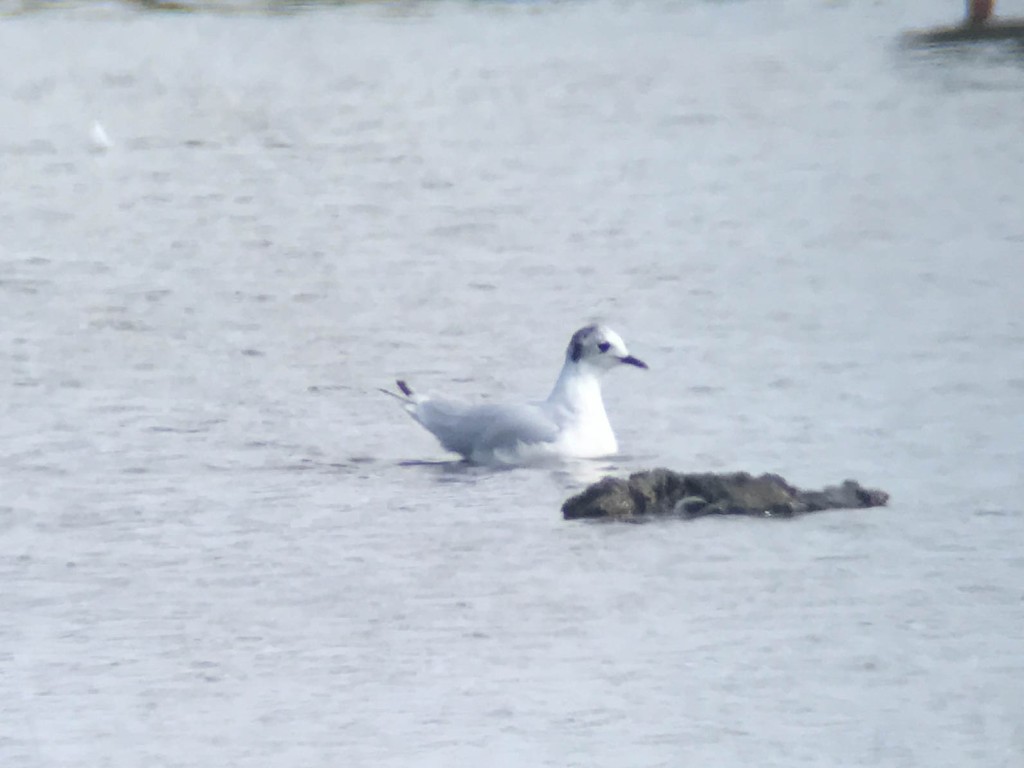
There was a nice selection of waders on the Serpentine too. A group of Black-tailed Godwits were probing busily into the deeper water, some still sporting bits of rusty breeding plumage. Another Green Sandpiper was asleep on the back edge of the water and a Common Sandpiper appeared on the mud at the front. A couple of Common Snipe were lurking on the edge of the grass and eventually worked up the courage to walk out into the shallows to feed. There were several Avocets and Lapwings too.
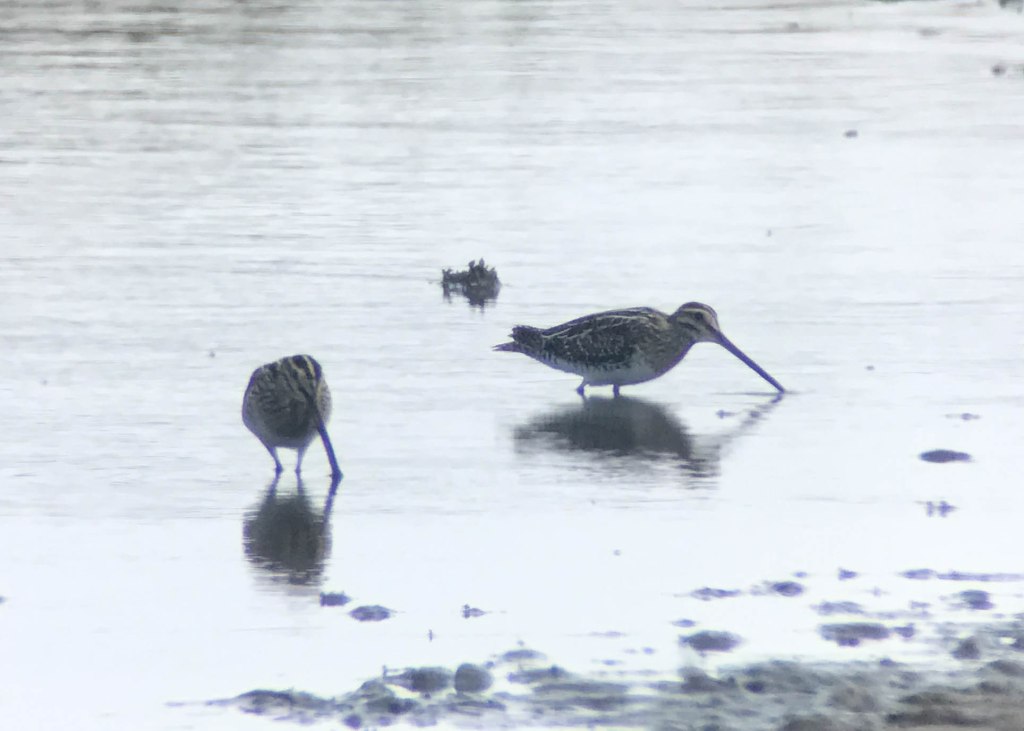
Continuing on, we stopped on the bank to scan over Arnold’s Marsh. There were lots of Curlew asleep on the saltmarsh in the back corner, and two Greenshanks and several Redshanks around the water. There were only a few terns today – three Sandwich Terns and two Common Terns were preening in the shallows in front of the small shingle island at the back, where the usual Cormorants were loafing.

We couldn’t come all this way without having a look at the sea, so we walked on the short distance to the beach. A Meadow Pipit flew in behind us and landed on the path. There were a few more terns offshore – mostly Sandwich but one Common Tern too, fishing just off the beach.
It was time for lunch, so we walked slowly back to the minibus. On the way, we heard Bearded Tits calling in the reeds again and just had a glimpse of one as it zipped away over the tops. A Reed Warbler had found a sheltered corner out of the wind on Don’s Pool and performed a little better. A Little Grebe had appeared on Snipe’s Marsh, but disappeared back into the reeds when it saw us coming.
We drove round to the Visitors Centre and had lunch on the picnic tables in the sunshine. There had been three Curlew Sandpipers reported earlier but a quick check up at the Centre after we had eaten suggested there was no further sign of them. We stopped to scan Pat’s Pool from the terrace with the scope, which revealed the Spotted Redshank which had also been around earlier, a very smart black individual, still in breeding plumage. There was a single Dunlin too.
We had one more place we wanted to visit this afternoon, so we decided not to go out to the hides today. We made our way back along the coast to Stiffkey. As we walked down the permissive path beside the road, there were lots of butterflies sheltering from the increasingly blustery breeze between the hedgerows, masses of Meadow Browns and Gatekeepers and a single Peacock basking on the path. A couple of metallic green female Banded Demoiselles were clinging to some ragwort flowers down by the copse.

The trees and bushes were rather quiet today. A Chiffchaff was flitting around in the bushes down by the river, calling. We were half way to the seawall when we came across a tit flock, but they were hard to see with everything so overgrown now. We eventually found a couple of Long-tailed Tits feeding in the sallows above the path.
A rather tatty Emperor Dragonfly was hiding in the long grass and a rather menacing looking but ultimately harmless Hornet Hoverfly Volucella zonaria buzzed ahead of us along the path and landed briefly in the hedge.
With all the vegetation so tall now, it is hard to see the Fen from the path by the river any more. We could just make out lots of large white shapes on the island, looking through the reeds. We had a better view from up on the seawall, where we could see that they were indeed Spoonbills. We counted at least 43, with more possibly out of view behind the reeds, a mixture of juveniles with shorter fleshy-coloured bills and adults with their long yellow-tipped black bills. The juveniles have come from the breeding colony at Holkham and are creched here while their parents go out to feed out on the saltmarsh at low tide.
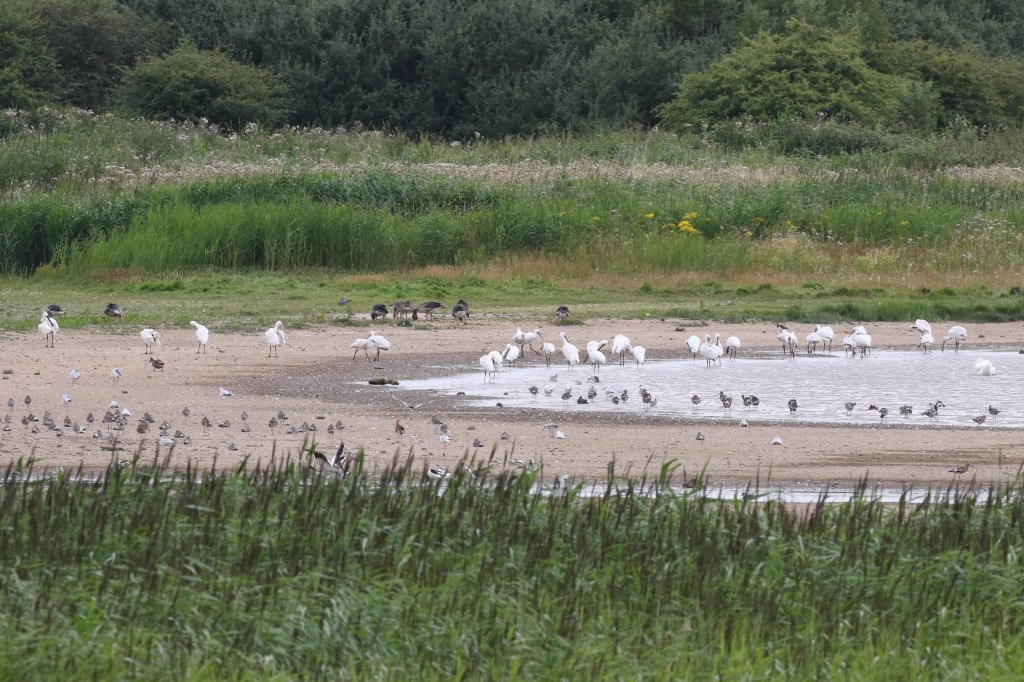
There were lots of Black-tailed Godwits loafing on the edge of the islands, coming from the harbour to roost on here with high tide only an hour or so away. A single juvenile Bar-tailed Godwit was chased out from behind the reeds by one of the local Avocets and we had a good view of it through the scope with the Black-tailed Godwits. We could see its more patterned upperparts and slightly upturned bill.
There were several more Green Sandpipers on here – we counted at least four this afternoon. And we had a very good view of a single Wood Sandpiper too. A scaly-backed juvenile Mediterranean Gull dropped in onto the island briefly.
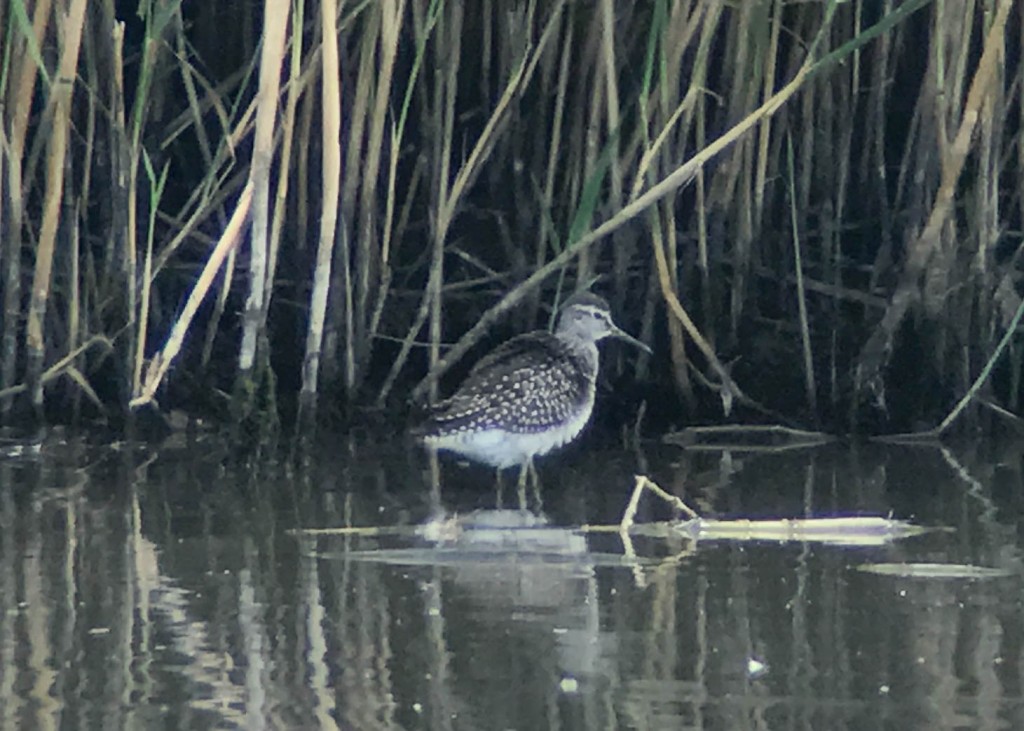
Looking out over the saltmarsh, we could see the seals gathered on the end of Blakeney Point and the sandbars beyond. A flotilla of boats appeared, ferrying people out to see them. There were some large flocks of Starlings out on the saltmarsh, which all landed at one point on one of the houseboats out in the middle, looking a little like bunting lined up on the rigging.
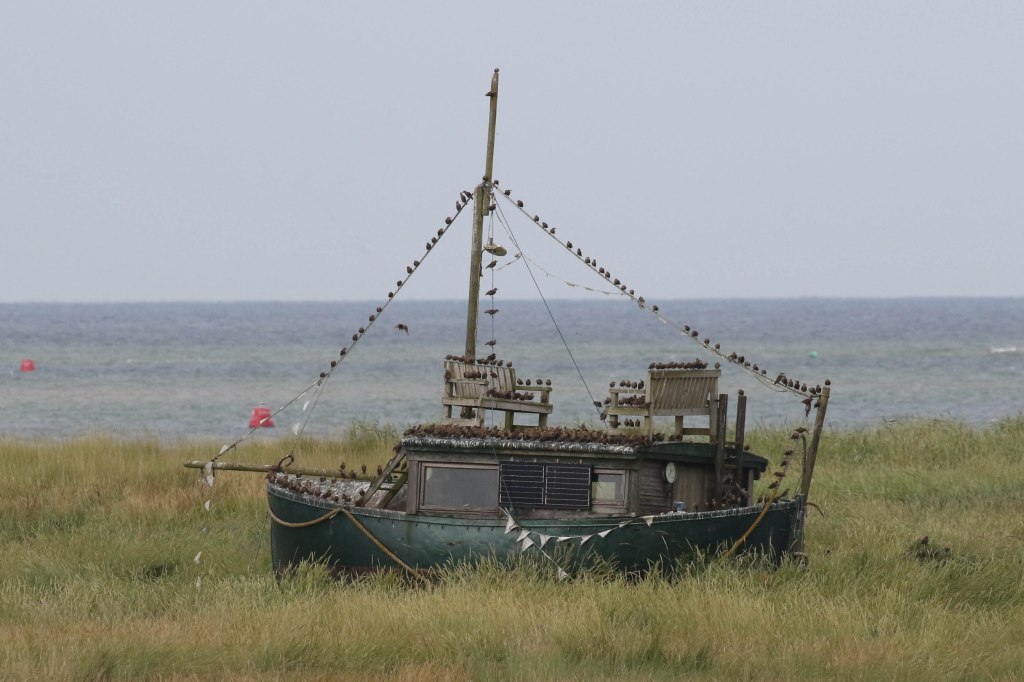
We walked on round to the harbour. The tide was still coming in and we could see lots of gulls loafing out on the mud, in various shapes and sizes. There were waders too – quite a few Grey Plover, most still sporting their stunning summer black faces and bellies, several Ringed Plover well camouflaged on the mud, a few bright summer Turnstones and orange-bellied Knot, lots of Oystercatchers. A single Whimbrel feeding on the mud was a nice bonus – we could see its humbug-striped head and shorter, downcurved bill.
We could have stayed here for hours, watching the tide come in and the world go by, but we had to get back in good time. It was time to call it a day.
















